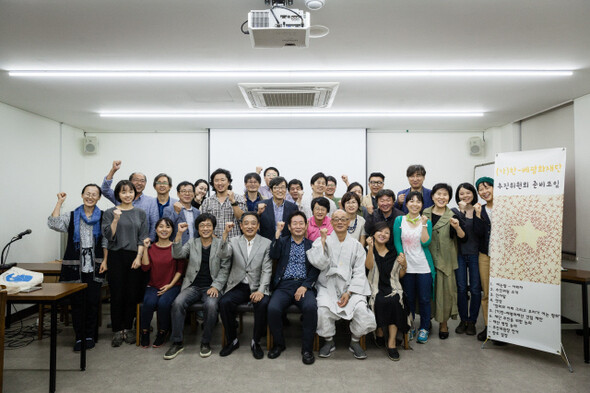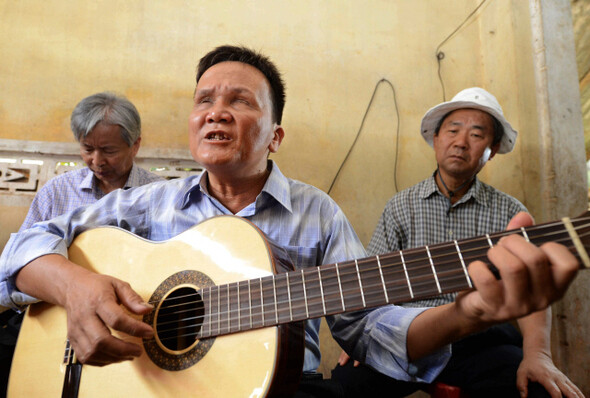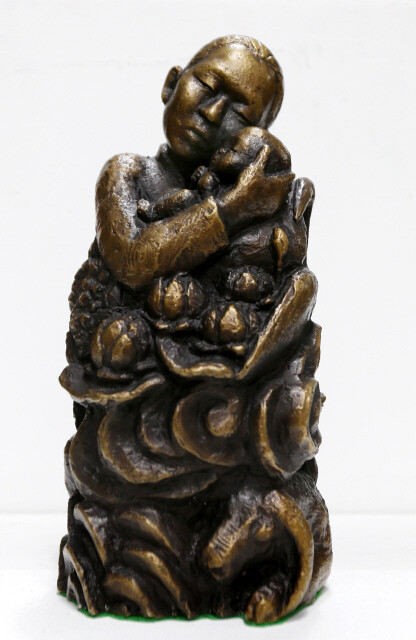hankyoreh
Links to other country sites 다른 나라 사이트 링크
A letter from Ku Su-jeong of the Korean-Vietnamese Peace Foundation

The organization behind the “Vietnam Pieta” bronze statue is the Korean-Vietnamese Peace Foundation, as it is tentatively named. One of the key figures involved with the foundation is Ku Su-jeong, a former Hankyoreh 21 correspondent in Ho Chi Minh City who first brought the ROK army’s massacre of civilians in the Vietnam War to the attention of the South Korean public in 1999.
Since the fall of last year, Ku has taken part in efforts to set up the foundation along with a number of people, including No Hwa-uk, a distinguished professor at the Far East University who is chairing the committee. In the following letter, Ku explains how the seeds of the foundation were sown and why she is working to set up the foundation.
***
As I remember, it was a very hot and muggy day in May 1994. “Shazai shimasu” – “I apologize” - said an old Japanese couple that I had run into on the campus of Vietnam National University. Right in front of me, the couple removed their shoes, got down on their knees, and lowered their head to the ground, repeating this bow several times.
Even though the rain was pouring down in the first squall of the year, the couple did not get up until their shoes, lined up in a neat row, were brimming over with rainwater. At the time, I had no idea that someday we Koreans would make the sad pilgrimage to Vietnam again and again to bow our heads low and make the same apology.
When I was wandering around central Vietnam in 1999, in the footsteps of the South Korean troops who were sent here during the Vietnam War, in most of the villages I was the first South Korean to show up in the 30 years since the massacres. Upon my arrival, the villagers would seize my hand and take me to memorials set up by the British and schools built by the Japanese. The massacre victims that I met there were wearing prosthetic legs that had been donated by the Germans.
I managed to keep my composure when I saw the memorials that had been erected in each and every village that ROK forces had passed through, when I faced the first monument to hatred for the ROK army, and when I stood in front of the graves of babies killed so soon after birth that they never even had a name. In Binh Hoa, I finally lost my composure altogether.

It was quite a while later that I visited Junko School. In 1993, Junko Takahashi, a student at Meiji Gakuin University in Japan, was on a stopover at the Vietnamese port of Da Nang during a Peace Boat tour when she happened to visit the village of Thuy Bo, the site of one civilian massacre by ROK troops.
Takahashi was shocked to see barefoot children wandering through the back alleys of the town because they had no school to go to. Back in Japan, she began collecting donations on the street and continued to do so until her unfortunate death in an automobile accident.
When Takahashi’s parents were cleaning up her room, they stumbled upon her diary, which described her dream of building a school in the village. Though she wasn’t able to achieve this during her life, her parents did so after her death, establishing Junko School.
When I entered the school grounds, a shout went up all around me that Junko had come. The little children of the village tagged along behind me, shouting, “Junko! Junko!” There, in Thuy Bo, I was okay with being called Junko instead of my real name.
Slow as it has been in coming, more and more South Koreans are starting to show their remorse to the Vietnamese.
In the Korean-Vietnamese Peace Park that was built in Phu Yen Province in 2003 with money donated by readers of Hankyoreh 21, the trees are finally starting to grow tall.
Peace and Medical Solidarity for Vietnam, a group that has been providing free consultations each year since 2000 in the areas where ROK troops were stationed, is now organizing its 17th trip to Vietnam.
A civic group called We and I has been organizing the Korean-Vietnamese Youth Peace Camp in Quang Nam Province, where the ROK “Blue Dragon” division was stationed. The group is paving roads, laying bridges, setting up memorials, and building kindergartens in the villages where massacres took place.
In Apr. 2015, Vietnamese survivors of ROK massacres visited South Korea for the first time, on the invitation of the Peace Museum.
But there are many more places that we aren’t able to reach.
In the village of Binh Hoa, which contains a monument of hatred for ROK troops, South Koreans are only allowed to go as far as the entrance to the village, where the office of the people’s committee is located. For the people of that village, the clock stopped on a certain day in Dec. 1966, and it has never started ticking again.
The resentment of the villagers is expressed in the cynical joke that it would have been better to be brutalized by the Americans than by the South Koreans. This is no doubt a reference to My Lai – the next village over – where the victims of a massacre by US troops are given aid by conscientious Americans, who have also built a hospital, a school, a museum, and parks.
But as for us South Koreans, they don’t even let us inside the village.
2015 was the 50th anniversary of the deployment of ROK forces to Vietnam, and starting this year there will be a series of memorial services marking the 50th anniversary of civilian massacres by the ROK army in various places throughout central Vietnam.
We are planning to put together a small South Korean delegation to attend the memorial service on the 50th anniversary of the Binh An massacre, which will take place this February. Even though we don’t have much to offer, we’ve made a pledge to begin to remember and to be there for the victims. That pledge is the foundation that we are tentatively calling the Korean-Vietnamese Peace Foundation.
In Sep. 2015, figures from various fields came together to launch the Committee for the Establishment of a Korean-Vietnamese Peace Foundation, to be chaired by No Hwa-uk, a professor at the Far East University. The participating figures include Bishop Kang U-il and Ven. Myeong-jin from the religious world; Lee Jeong-u, Han Hong-gu, Bang Hyeon-seok and Kwon In-suk from the academy; and Yu Hong-jun, Lee Cheol-su, Lim Ok-sang and Jeong Ji-yeong from the area of arts and culture.
The purpose of the foundation is to help South Korea and Vietnam heal the wounds and suffering of the war, and beyond that to usher in a future of peaceful coexistence in East Asia. Toward this end, the foundation seeks to forge ties with civic groups in the Asian region in order to train the next generation of activists for peace and human rights, who can build a framework for a peace movement on the Korean Peninsula and in Asia.

As the first step in that direction, we are running the campaign to set up copies of the “Vietnam Pieta” bronze statue, created by the sculptors Kim Seo-gyeong and Kim Woon-seong, and organizing the Korean-Vietnamese Peace Art Exhibition in order to raise funds for the Korean-Vietnamese Peace Foundation.
Apologizing to Vietnam is not just good for the victims. South Koreans have not healed the wounds of war, and this will be a chance to get rid of the violence inside us. Another reason is that it’s only by making peace with our memories of the past that we can dream about peace in our future.
When I was outraged by Japanese Prime Minister Shinzo Abe’s soulless apology to the comfort women, I was fortunately reminded of the apology given me by the old Japanese couple. That apology enabled me to preserve my hope in humanity, which shines on stubbornly no matter how much I may despair.
Remorse that’s not preceded by keen introspection resulting from long hours of reflection, apologies that aren’t supported by backbreaking effort – these may be no more than a false kind of absolution that leads in the end to irresponsibility and forgetfulness.
I believe that peace must begin with a second generation of numberless Junkos who embrace other people’s suffering as their own and endure the same kind of suffering. We’re looking for people who will help us lead the Korean-Vietnamese Peace Foundation. We look forward to your generous support.
By Ku Su-jeong, Korean-Vietnamese Peace Foundation member
Please direct questions or comments to [english@hani.co.kr]

Editorial・opinion
![[Guest essay] The real reason Korea’s new right wants to dub Rhee a founding father [Guest essay] The real reason Korea’s new right wants to dub Rhee a founding father](https://flexible.img.hani.co.kr/flexible/normal/500/300/imgdb/original/2024/0423/8317138574257878.jpg) [Guest essay] The real reason Korea’s new right wants to dub Rhee a founding father
[Guest essay] The real reason Korea’s new right wants to dub Rhee a founding father![[Column] ‘Choson’: Is it time we start referring to N. Korea in its own terms? [Column] ‘Choson’: Is it time we start referring to N. Korea in its own terms?](https://flexible.img.hani.co.kr/flexible/normal/500/300/imgdb/original/2024/0423/3617138579390322.jpg) [Column] ‘Choson’: Is it time we start referring to N. Korea in its own terms?
[Column] ‘Choson’: Is it time we start referring to N. Korea in its own terms?- [Editorial] Japan’s rewriting of history with Korea has gone too far
- [Column] The president’s questionable capacity for dialogue
- [Column] Are chaebol firms just pizza pies for families to divvy up as they please?
- [Column] Has Korea, too, crossed the Rubicon on China?
- [Correspondent’s column] In Japan’s alliance with US, echoes of its past alliances with UK
- [Editorial] Does Yoon think the Korean public is wrong?
- [Editorial] As it bolsters its alliance with US, Japan must be accountable for past
- [Guest essay] Amending the Constitution is Yoon’s key to leaving office in public’s good graces
Most viewed articles
- 1[Column] ‘Choson’: Is it time we start referring to N. Korea in its own terms?
- 2Why Korea shouldn’t welcome Japan’s newly beefed up defense cooperation with US
- 3[Guest essay] The real reason Korea’s new right wants to dub Rhee a founding father
- 4Samsung barricades office as unionized workers strike for better conditions
- 5Senior doctors cut hours, prepare to resign as government refuses to scrap medical reform plan
- 6[Editorial] Japan’s rewriting of history with Korea has gone too far
- 7[Column] The clock is ticking for Korea’s first lady
- 8Opposition calls Yoon’s chief of staff appointment a ‘slap in the face’
- 9New AI-based translation tools make their way into everyday life in Korea
- 10Korean government’s compromise plan for medical reform swiftly rejected by doctors